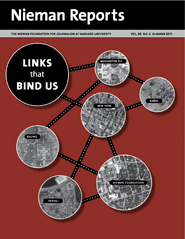Editor’s Note: Our sister publication Nieman Reports is out with its summer 2011 issue, “Links That Bind Us,” which focuses on the role community plays in journalism. We’re highlighting a few entries that connect with subjects we follow at the Lab, but go read the whole issue. In this piece, Michael Skoler writes about the (monetary) value of community.
 A few years ago, Public Radio International coaxed its most popular host, Ira Glass of “This American Life,” into digital cinema. Ira had already expanded his famed radio program into a traveling stage show that toured a dozen cities a year. With this new idea he would perform one show and beam it live to hundreds of movie theaters around the United States at the same time. Efficient, yes, but would it be appealing, Ira wondered.
A few years ago, Public Radio International coaxed its most popular host, Ira Glass of “This American Life,” into digital cinema. Ira had already expanded his famed radio program into a traveling stage show that toured a dozen cities a year. With this new idea he would perform one show and beam it live to hundreds of movie theaters around the United States at the same time. Efficient, yes, but would it be appealing, Ira wondered.
After all, people came to see him and even hoped to meet him. Radio is an intimate medium, and with Ira, so is a live show. What would be appealing about watching him on a screen from thousands of miles away in the company of a hundred strangers? This wasn’t a sporting event — the main draw for digital cinema — it was journalism, storytelling journalism. And people could already watch Ira on DVD.
So would they come and pay $20 a ticket?
They came in droves. More than 30,000 watched the first digital show at hundreds of theaters across the U.S. and Canada in the spring of 2008. The next year, 47,000 turned out. They came to be with other fans, experiencing something they all loved together. The success wasn’t so much the power of Ira, but the power of his community.